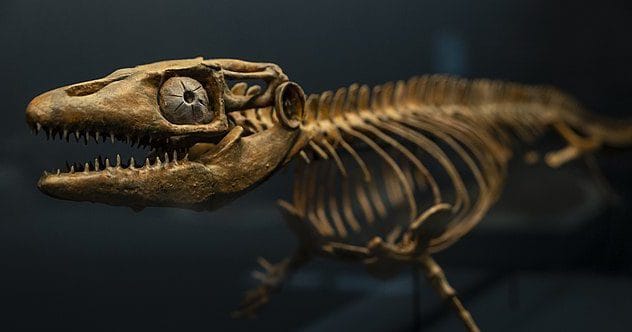The age of dinosaurs sparks our imagination, a time when colossal reptiles roamed the Earth. For an incredible 165 million years, they were the dominant force across every continent. But the world they lived in wasn’t empty; dinosaurs shared their planet with a host of other animals, many of which were just as strange and wonderful. You might be surprised by some of the critters that scurried, swam, and existed in the shadows of these giants.
In this journey back in time, we’ll explore creatures that aren’t usually in the spotlight. We’re focusing on animals outside the Archosaur group, which includes dinosaurs, their bird descendants, pterosaurs, and ancient crocodilians. Get ready to meet some truly peculiar residents of the Mesozoic Era!
10. The Sort-of Turtle: Sinosaurosphargis yunguiensis
Imagine a creature from 243 million years ago in what is now southwestern China. Sinosaurosphargis yunguiensis looked a lot like a turtle, especially with its wide ribcage forming a shell-like structure. However, its “shell” wasn’t like many modern turtles that have large, hardened scales. Instead, it was made up of many small, bony deposits in the skin called osteoderms.
Here’s the twist: Sinosaurosphargis wasn’t actually a turtle! It did share a common ancestor with turtles, but its branch on the family tree split off millions of years before true turtles appeared. Interestingly, the bony armor of this creature puzzled scientists because early true turtles didn’t have this feature, making Sinosaurosphargis a fascinating specimen in understanding reptile evolution.
9. The Not-Quite-First Mammal: Megazostrodon
Picture a tiny animal, perhaps resembling a strange shrew or rat, scurrying across the arid landscapes of Late Triassic France about 200 million years ago. This was Megazostrodon, a small creature holding immense significance for paleontologists.
Megazostrodon is considered a key transitional form. It bridges the gap between the mammal-like cynodonts and the true mammals we know today. This makes it a crucial piece in the puzzle of mammal evolution. Despite its importance, its exact position on the mammalian family tree is still debated, as is the precise moment when mammals truly became “mammals.” While scientists ponder its place, Megazostrodon was likely too busy munching on insects to care about its complex evolutionary status.
8. The Ancient Tuatara Relatives: Sphenodontia
This one is a bit of a group feature! We’re not just talking about the modern tuatara (Sphenodon punctatus) found in New Zealand, but its entire ancient order, Sphenodontia. These reptiles were already well-established by the early Jurassic, nearly 200 million years ago, and were once a very diverse group.
Sphenodontids belong to a larger group called Rhynchocephalians, which are evolutionary cousins to modern lizards and snakes (Squamates). Think of them as a varied collection of not-quite-lizards; they looked similar but were distinct enough to be classified separately. Sadly, all Rhynchocephalians, except for the single genus Sphenodon (the tuatara), dwindled and went extinct millions of years ago. Today, only the tuatara remains, a living fossil facing threats from human activities.
7. The Fish Lizard: Stenopterygius
Ichthyosaurs, meaning “fish lizards,” were a diverse group of marine reptiles that first appeared around 250 million years ago. For our list, we’re highlighting Stenopterygius, a dolphin-like ichthyosaur that lived about 180 million years ago. Why this one? A remarkably well-preserved fossil has shown us just how peculiar these creatures were.
This special fossil didn’t just preserve bones; it showed traces of skin pigment and, amazingly, a layer of blubber underneath its skin. While this doesn’t definitively prove they were warm-blooded like mammals, it strongly suggests they could regulate their body temperature to some degree. This would have been vital for a reptile that frequently dived into cold, deep ocean waters. Ichthyosaurs were once among the top predators of the Mesozoic seas, but they eventually went extinct around 90 million years ago, about 25 million years before the non-avian dinosaurs vanished.
6. The Beaver-Otter Hybrid: Castorocauda lutrasimilis
Castorocauda lutrasimilis is a fantastic example of how nature sometimes reuses successful designs. Living 164 million years ago, much of its body looked surprisingly similar to a modern beaver, complete with a flattened, scaly tail and webbed feet. It’s like seeing a familiar blueprint in an ancient animal!
But this creature wasn’t an early rodent. Its narrow skull housed many sharp, needle-like teeth perfect for catching fish, much like modern otters. What’s even more fascinating is that its fur was remarkably similar to that of modern aquatic mammals, featuring guard hairs and a dense undercoat for insulation. Unlike most mammals today, Castorocauda likely laid eggs, leading some scientists to suggest its lifestyle might have resembled that of the modern platypus – a truly unique combination of traits!
5. The Long Lizard (Not a Snake!): Tetrapodophis amplectus
The story of how snakes lost their limbs is one of paleontology’s hot debates. So, when a fossil of a serpentine reptile from Brazil mysteriously appeared in Germany, it caused quite a stir. This fossil seemed to show an animal with four limbs, which was a huge deal because most primitive snake fossils known only had one set of limbs, if any.
This creature, Tetrapodophis amplectus, lived during the Early Cretaceous, about 120 million years ago. Hopes were high that it was the missing link – a four-limbed snake. However, further study revealed it was actually a very long lizard, not a snake. But it still taught us something important! Tetrapodophis was a burrower, and the structure of its tiny limbs has been compared to those of early snakes. It’s now thought that snakes might have lost their limbs to become better burrowers, just like this ancient lizard.
4. The Ancient Platypus: Teinolophos trusleri
Just when you thought prehistoric animals couldn’t get weirder, meet the ancestors of the platypus! Modern monotremes, the group that includes the platypus and echidnas, come from a very old lineage, though exactly how old is still debated by scientists. Estimates for when they split from other mammal lineages range from the Early Triassic to the Jurassic periods.
The oldest known platypus relative, Teinolophos trusleri, lived in the Early Cretaceous about 120 million years ago. Many other related species soon followed. While most of these fossils are incomplete, they suggest that the unique traits making the modern platypus so famously odd – like its bill and egg-laying – started to develop way back then. Though only one platypus species survives today, they were once a diverse group whose range even extended beyond Australia, with fossils like Monotrematum sudamericanum found in South America. And here’s a fun fact: the echidna, another wonderfully weird monotreme, branched off from a platypus relative possibly 20 to 50 million years ago, or even earlier!
3. The Antarctic Sea Dragon: Kaikaifilu hervei
Imagine a colossal marine reptile ruling the Antarctic seas 66 million years ago, right at the end of the dinosaur era. This was Kaikaifilu hervei, a mosasaur recently featured in BBC’s “Prehistoric Planet.” Mosasaurs were giant marine reptiles closely related to modern lizards and snakes.
Kaikaifilu was a type of tylosaurine mosasaur, which means it had a longer, more snake-like body compared to the bulkier mosasaurine types. It’s estimated to have been an impressive 33 feet (10 meters) long, making it the largest known mosasaur from the South Pole and likely the apex predator of its region. Its reign was powerful but short-lived, as all mosasaurs, including Kaikaifilu, went extinct at the end of the Cretaceous period along with the non-avian dinosaurs.
2. The “Crazy Beast”: Adalatherium hui
Adalatherium hui, a creature from Madagascar dating back 66 million years ago, truly lives up to its name, which means “crazy beast.” Lead researcher David Krause said, “Knowing what we know about the skeletal anatomy of all living and extinct mammals, it is difficult to imagine that a mammal-like Adalatherium could have evolved; it bends and even breaks a lot of rules.”
This animal was exceptionally weird. For starters, it had more holes in its skull than any other known mammal. Its teeth were unlike any other mammal’s. It possessed more vertebrae than any of its contemporaries. Scientists also struggled to figure out how it walked because its front half didn’t seem to match its back half! This seven-pound (3-kilogram) oddity was likely still a juvenile, meaning an adult could have been even more perplexing. Adalatherium truly challenges our understanding of early mammal diversity.
1. The Earliest Primates: Purgatorius janisae
We might be stretching the timeline a tiny bit here, but it’s too fascinating to ignore! Purgatorius janisae is considered one of the earliest primates, or perhaps a direct predecessor to primates. Its fossils are mostly known from just after the Cretaceous extinction event. However, scientific studies suggest this genus is likely much older, potentially dating back to around 81 million years ago, meaning it could have lived alongside the last dinosaurs.
What did Purgatorius look like? Imagine a creature that was a mix between a ferret and a squirrel. More importantly, it had flexible ankle and wrist joints – a key feature that would become a hallmark of later primates. These adaptations allowed it to thrive in the treetops, keeping it safe from many ground-dwelling predators. From these humble, tree-dwelling beginnings, the primate lineage, which eventually includes humans, would embark on an incredible evolutionary journey.
The Mesozoic Era was clearly teeming with more than just dinosaurs. These ten creatures offer a glimpse into the incredible biodiversity that shared the planet. From turtle look-alikes to bizarre early mammals and marine giants, life found countless ways to thrive. These animals paint a richer, more complex picture of a prehistoric world that continues to amaze us.
Which of these ancient critters do you find the most fascinating? Did any of them surprise you? Leave your comment below and share your thoughts!










